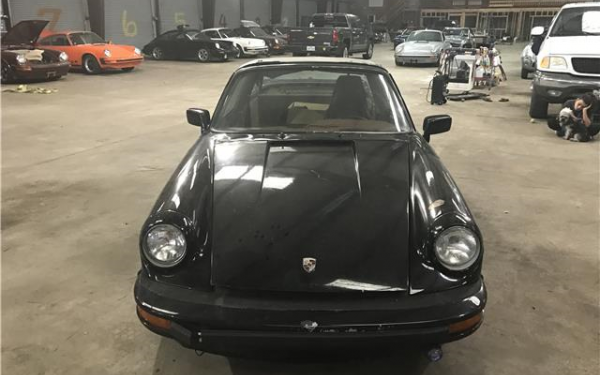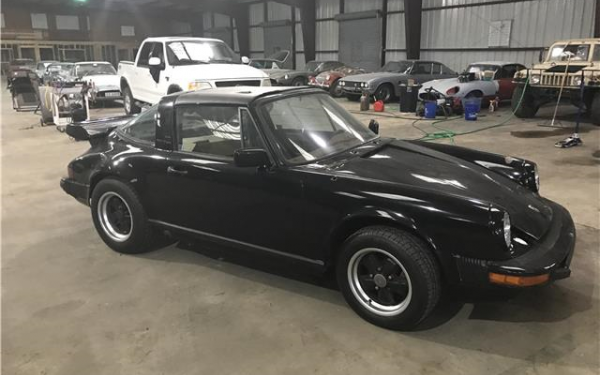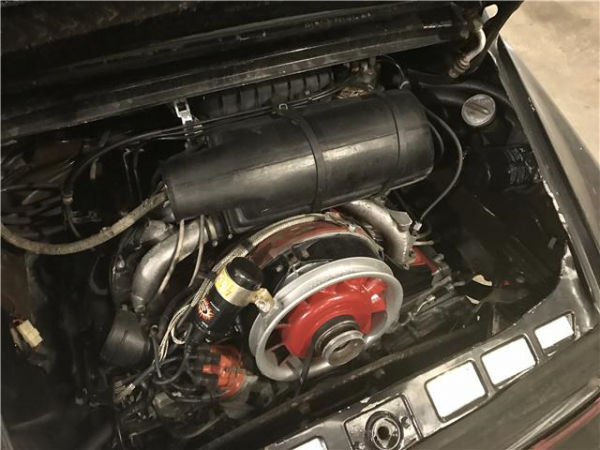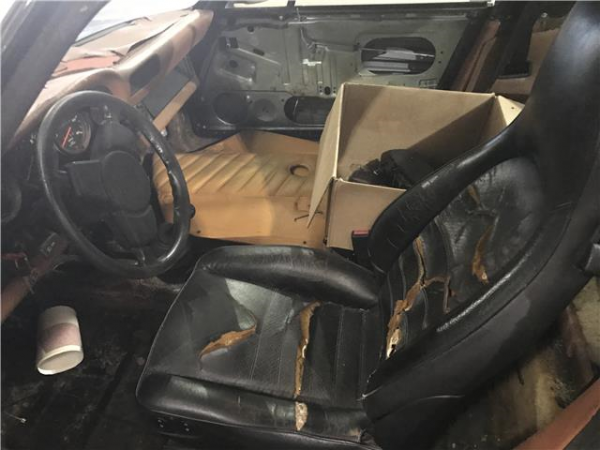Do you remember “tulip mania” from your history classes in school? If you were sleeping that day, then I’ll help you. Basically, in 1637, a new type of tulip bulb hit the market, and demand rapidly outpaced supply. People from all walks of life sunk what they could in a tulip bulb market that rapidly soared to incredible heights, and, just as quickly, came crashing back down to Earth. This event is considered the first recorded speculative bubble in economic history. Since then, there have been many more occurrences such as this, all with the same outcomes. In the automotive world, we have seen the forces of supply and demand go crazy many times. This year, the big story is the sudden rise of Porsche 911 prices. All types of 911s are coming out of the woodwork to take advantage of this surge in prices. The example seen above, found on eBay out of Dallas, Texas for the buy it now price of $19,500, is just one of the many 911s on the market right now.
The Porsche 911 was the successor to the earlier 356 model. While the 356 was a four cylinder, and weighed far less than its competitors, they were soon greatly in demand among enthusiasts worldwide. In racing, they built Porsche’s reputation as giant killers because they often won against cars that were far more powerful. Porsche had a tall order on their hands when it came time to replace the 356, and the 911 was a success in every way. With their racing bred handling and their incredibly beautiful silhouette, 911s have captured the hearts of millions of enthusiasts. Unbelievably, variants of the 911 has been in production since 1965. While today’s car is very different from the original, the basic shape and feel are much the same. They are a car that is in high demand among enthusiasts, and time, accidents, and rust have reduced the number of good cars to a point where prices have risen rapidly.
The question I want to know the answer to is simple. Is this rise in price justified? Let’s answer that by looking at the facts. First off, 356 prices have taken off to levels that most didn’t expect. Cars that would have been considered mediocre parts cars just a few years ago are selling in the $20,000-$30,000 range. A good, running 356 can still be had for around $50,000, but it is more likely than not going to have a flaw like a non-numbers matching engine, a poor rust patching job, or a mediocre overall condition. Rarer and/or excellent condition 356s are steaming past $100,000, and even those crappy VW Beetle based speedster replicas that used to be advertised in the back of Popular Mechanics are selling for up to $30,000. Crazy. It seems that this sudden rise in 356 prices has unleashed a panic in the 911 market, as they look at the horizon and see a massive Mongol Horde of speculators coming at a full gallop. Early 911s, which were not very popular for a number of years in comparison to the more modern versions, suddenly took off in value as well. This rising tide has brought Porsche prices up in the later 911, 914, 944, and even early 924 markets.
Our second point of discussion is the 911’s fabled driving characteristics. While they are beautiful cars, they are not for everyone. The air cooled engine is at the rear, so this puts extra weight in the area you least want it to be for good handling. Porsche has always made this work through such tricks as using weights in the front bumpers of early cars, aerodynamic tweaks, suspension work, and, more recently, electronic aids. Untrained drivers can get themselves in a lot of trouble very quickly in a 911, especially if they lose their nerve in a sharp corner and get on the brakes. Bobby Allison, who knew a thing or two about going fast in a car, bought a street model 911 to drive in preparation for competing in the IROC series that year. He was in no way complimentary concerning the handling of 911s in a February 1974 Car and Driver article, complaining about the excessive oversteer and the instability of the cars near the limit. He caught a lot of flak for voicing his unvarnished opinion, but if Bobby Allison had trouble driving one fast, what kind of boat would the average driver find themselves in at the limit?
The third point is the cost of ownership. It is often said that a cheap Porsche is the most expensive Porsche to buy. Take the engine for example. A complete rebuild on a 911 now runs somewhere in the neighborhood of $10,000 if you have it done by a reputable shop, and you have a good engine to work with. You could rebuild it yourself for less, but it isn’t the same thing as rebuilding your small block Chevy. Every part you have to order is expensive. Take a gander at the prices at some of the bigger Porsche parts houses and you’ll see what I mean. Heaven forbid you have to order from Porsche themselves. On the good side, these are durable cars, and their components are usually well made and last a long time worth proper care. Unfortunately, like the Porsche in this EBay advertisement, a lot of cars don’t get proper care.
This particular Porsche is a perfect example of how this seller’s market has driven prices up on 911s. This 1979 911 has obviously not been treated very well. The owner claims that it runs and “will move under its own power.” That statement would scare me if I were a prospective buyer. The owner further states that the car is very straight and solid, but that the body and interior are rough. I really like the black exterior with the black leather seats and the tan interior trim. The whale tail I can take or leave. I’d keep it if I were planning on adding wider rear fenders, which would probably make sense if the car needed a complete repaint and some body work. The interior situation would certainly run into money. A lot of money if all new components were used.
I don’t mean to sound down on 911s. They are a bucket list car for me, and I have spent many hours admiring them. I am just worried that the incredible demand and subsequent rise in prices have honest collectors grabbing any 911 they can find in their price range. If that price range allows for a car that has been well taken care of that has all the proper maintenance records, then that is fantastic. They will likely enjoy the car, and won’t end up being burned when they decide to sell it. The danger comes with the cheaper cars that have been used and abused. These cars can quickly turn into a giant hole to throw money down, and, when they are sold again in frustration, they can really leave the owner upside down financially. When you factor all of this in with the handling, you see how purchasing and owning a 911 is a unique experience that not every enthusiast is well suited for. I just wonder where the number of realistic buyers stands in relation to the number of good 911s available on the market.
If the 911 is the car you always wanted, then now is likely the time to find a very good example. Just be careful what you wish for.






I knew I could kick Bobby’s butt in a tight corner in a Porsche…………
A great writeup!
Agreed, very nice work.
The ship has sailed. The time to buy a 911 was about 5 years ago. Buying now would be like stretching to buy a house in 2008. You’re more likely than not to get pinched when the market sags. When you can’t take it to the market or park it on the street, they’re not cars any more.
I used to share some of the same reservations you voice about the 911. I am not familiar with earlier cars but have owned a 993, the last version of the original 911, for about 9 years now. It is sports car perfection and would part with it only for a great amount of money. Cars with personality like the 911 will never be made again. There are many other fine sport cars, but the 911 is uniquely special.
Good right up, but I think your 10k engine rebuild price may be low.
I had a 911 many, many years ago. I purchased it rather cheaply as it had dropped a valve and did nasty things to the engine. Instead of rebuilding it I just dropped a later 3 liter in it.
I enjoyed driving the car, but it did not suffer fools. It was a car that you had to get all your braking done before the corner and on the gas coming out. Brakes were phenomenal for the time period.
I did not keep the car for long and sold it for money to go back to college and I never really wanted another one preferring Italian cars instead.
The things I didn’t like about. I never felt comfortable driving it, the shifter was vague, ergonomics were really a disaster and I really never warmed to the sound of the flat 6. Its biggest fault was that it was not a bad car but it did not stir any passion for me. I look prices that they are asking for them now and scratch my head, but I don’t have any regrets selling it.
As I have said on BF before, I also like the body design of the 911, especially the early cars. But it’s all downhill from there, especially for the things that you mentioned.
The Porsche racing record is one of the best of any brand in history, which counts for a lot among buyers of the brand. But that doesn’t help with all the big and little limitations the cars have when you are living with them as a frequent driver.
I feel the peak has passed. Brexit killed it. Without the Brits pound so big, there is less driving the price.It was cooling anyway, tho. Everything goes up and then down.
Thank you to all for the nice compliments on the write up. It wasn’t easy to strike a balance between respecting the car and the brand, and being up front with the limitations of the 911. They are nice cars, but I am afraid a lot of the people buying them have no idea what they are getting into, both financially and from a drivers standpoint.
As for performance, there is a reason why Porsche never offered their top 911 engines in 914s or Caymans.
I think that the Porsche market hasn’t crested yet, believe it or not–but it will, eventually. Reason being is that the people who lusted after these cars in their youth are still “young” enough to still drive them. On the other hand, we are already witnessing the bubble popping on 50s and 60s collectibles and muscle cars as Baby Boomers die of old age, or enter retirement homes.
Would also like to add that the 356 market WILL pop soon, because those are Boomer cars. The 911 market still has a long time to go (I say this as a Gen Xer who ogled 911s just like this one in the ad in my childhood. The 356, on the other hand just looks like some primitive car wearing a mumu body shell to me).
I own a 1990 911 (964). It is a track car with almost 200,000 miles on it. It has been driven very hard but has received great maintenance its whole life. Although I have owned three Porsches previously this is the first one I have maintained myself and taken apart. I was shocked with the comparison to other cars I have owned (Corvettes, Mustangs and other American stuff). The quality and engineering is beyond belief. Just as an example, where an American car would hold two panels together with a sheet metal screw that will eventually work loose, the Porsche uses backing nuts and other much more expensive methods to hold pieces together. When you take an American car apart and put it back together nothing fits quite the same again and some banging around is required. With the Porsche the parts are designed and manufactured so well that it is a breeze to reassemble.
What is happening is that people are learning about this quality and although there certainly has been a big rise in prices, I doubt it will retreat much if any.
Take a look at the attached photo. This is the original paint on a 200,000 mile car, half of that on a HPDE track going balls out. Doors and trunk open like it was new. Fit is still great. That is why they will hold their value.
Yes, nice write-up. I’ve owned my 2002 911 cabriolet now for 6 years and 50,000 miles. It is without a doubt the finest automobile I’ve ever experienced. Now that’s because (a) I bought it with 60,000 miles on it and a flawless documentation of maintenance, (b) I knew exactly why I was buying it…to DRIVE it. That was my purpose. Others want collectibles that are rarely driven, some own it for prestige but don’t know the first thing about how to drive one. Some buy them to flip and turn a profit. I’m not being judge mental, just saying that with any purchase you have to know WHY you are buying it. Mine is a daily driver, and the chips on the front are proud reminders of racing Mid-Ohio and Sebring. And that also means more maintenance. I’m pretty sure what I just wrote applies to most any high end sports cars, not just a 911.
I have owned much more than my share of air cooled 911s so take my comments as such.
I’m going to have to disagree on most of the points brought up in this article. You really need to own one of these cars to understand them. Otherwise, you are just restating old outdated opinion.
1) The market on 911s was not driven up by 356s but by true demand for air cooled 911s. These cars have been undervalued for years and have really just come to the level they deserve. Like it or not, a 911 is going to cost real money to own. I don’t expect a bubble like the tulips you described above. With the tulips, the supply increased. They aren’t making any more air cooled 911s. I do believe 911 prices have stabilized but they are never going back to the levels they were a few years ago. Many say that 356 prices were a bubble as well when they increased in value but those as well just stabilized at the levels they are now.
2) I absolutely disagree on the driving characteristics arguement. That’s just a tired old argument. The characteristics that are claimed to be so bad are actually what makes them so competitive. The 911 is one of if not the winningest model car to ever compete. The early cars had a reputation for going off the track due to skinny tires and bad driving but they still won time and time again. With today’s tire technology these cars are even faster. The roughly 40/60 weight ratio is something Porsche stumbles upon with the 911 but it works. There’s a reason formula one cars have a rear weight bias. It’s faster. As far as the old argument that Porsche “held back” the 914 etc. That’s just not true either. There were and are still lots of well built “other” model Porsche’s out there racing vintage and competitive with as much HP as their 911 counterparts. While these cars may come on top some, the 911 still is the most consistent winner. Bobby Allison might not have like his particular 911 that was set up in a particular way for him, but that doesn’t negate all of the other drivers who found great success in one.
3) Cost of ownership can be expensive if you don’t wrench on them yourself. I will concede that point but a significant portion of the cost is the shop “porsche” surcharge. If you can maintain any car yourself, you will find an air cooled 911 to be one of the simplest to maintain. A rebuild can be expensive but how many 911 owners have to cross that bridge? If they do, you get what you pay for. While it may cost $10k, a proper rebuild is good for 200k miles or better. Can you say that for the inexpensive chevy 350 build?
Most of the 911s I come across are driven regularly by their owners. Most of them are not show show pieces and they were never intended to be. Porsche set out to build a car that the owner could drive to work Mon-Fri and take to the track on the weekend. In that, they were very successful. They aren’t daily drivers anymore but what 25+ year old car is? I drive mine hard every time I get in it and it keeps asking for more.
These are great “experience” cars that one can never get from any other car. If you haven’t owned one, you can’t understand the appeal. A test drive or two won’t cut it. I suggest the author jump in and cross 911 ownership off his bucket list. Then he can be as biased as I am. :)
One of my favorite years in that car absolutely beautiful what a little bit of money you can have yourself a real gorgeous car